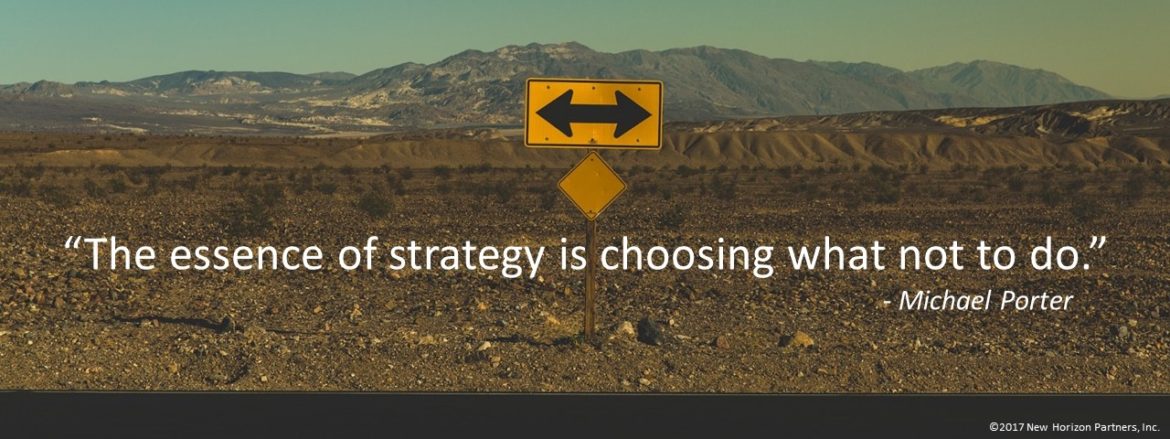An effective strategy sets the direction for the business but it also should be specific enough to say no – no to pursuing certain customers, no to entering certain markets, no to certain programs or investments, no to hiring a certain person. The strategy says no to choices that diverge from the optimal direction for the business to achieve its objectives.
Business strategy sets the direction for an organization by describing where and how the business will compete in order to provide value to the customer that will lead to accomplishing the organization’s strategic objectives. The purpose of strategic planning is to provide a clear and succinct statement of the organization’s strategy that can guide decisions within the organization. Strategy should focus the organization’s efforts to those with the highest return potential. The strategy then becomes a screen that sifts through decisions regarding which business opportunities to pursue and about the allocation of resources. With an effective plan and management process the organization can then say yes to the right opportunities and no to the suboptimal choices.

The business strategy provides a means to screen business opportunities. The organization should be able to compare every new business opportunity with the parameters of where and how to compete that is described in the strategy and decide if it fits. Sometimes organizations write what they call strategy in broad, vague terms because they do not want to limit their business options. One reason for this is that they are desperate to find any revenue to survive and fear passing by any revenue source, even those that will detract from their long-term profitability potential. A second possible reason is that they are incapable of properly positioning their business. To position the business requires a good understanding of customers and their needs, not just today’s needs but also evolving needs. It also requires an understanding of the organization’s core competencies and how these competencies can match with customer needs.
The business opportunities that maximize return are those where the organization can provide unique value based on its core competencies. The core competencies either provide a unique value to customers or they provide a unique economic advantage in generating solutions to customer needs. The strategy needs to clearly demonstrate how the organization is building its core competencies and what customer needs it seeks to fulfill. (For more thoughts on this, see the strategy example article.) Business opportunities that align with the strategy should be considered and pursued. Business opportunities that do not align with the strategy distract from a pursuit of competitive advantage and will not generate optimal returns. Those business opportunities that do not fall within the business strategy should be discarded.
Strategy also guides the organization in its allocation of resources. Resources applied to building core competencies that then lead to competitive advantage in providing value to the customer have the potential to generate a higher return. Scattering resources among a variety of programs that are not strategy driven dilutes efforts and resources. The strategy provides a means to screen projects and resource decisions. If a project or decision cannot demonstrate strategic value, the answer should be no.
We see then two common mistakes that organizations make in their strategic planning efforts. First, by not thinking deeply enough or not recognizing the value and purpose of effective strategic planning, they might not develop a plan with the clarity and specificity to actually guide any decisions. A second mistake is not recognizing the purpose of planning to guide every decision. In order to do so, the strategic plan needs to be clearly communicated to the organization and held out as the signpost providing direction for the long-term development of the business.
Does your strategic plan optimize your decision process?

6 Comments
More often than not the “delete” button is more powerful than the “save.”
Thanks, Chris. Interesting way to state it.
The need to drill down, think hard and then carefully develop a strategy is paramount. The willingness to say “No” to an otherwise attractive idea can be very hard to resist, however, being distracted by every promising opportunity that comes across the desk is no way to run a successful business ,at least over the long haul.
Thanks, John. Your comment reminded me that strategy should be like a set of blinders to keep us from getting distracted by every pretty butterfly that floats by.
Hi Ken,
Sound information, however I would argue strongly as I do with many of my clients…”any strategy is only as good as the execution plan that supports it”.
Many strategies become obsolete or fall well short of the mark due to poor execution! (MJ)
Absslutely, Mark. Strategy should guide our decisions and actions.
Add your comment